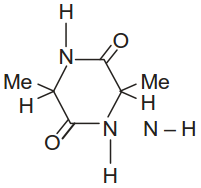
The above process in which a and b form remain in equilibrium with acyclic form and a change in optical rotation is observed which is called as–
(1) Mutarotation
(2) Epimerisation
(3) Condensation
(4) Inversion

How many moles of HIO4 is required to break down the following molecule?
1. 1
2. 2
3. 3
4. 4
Nitrous acid (HNO2) converts amino acids into hydroxy acids with retention of configuration.
Estimation of nitrogen gas evolved in the reaction is the basis of Van slyke estimation of amino acids. Which of the following amino acids cannot be analysed by Van slyke method?
Codes :
(1) only I
(2) only II
(3) I and III
(4) I, III, IV
Which of the following aldohexoses give the same osazone derivative ?
(1) I and IV
(2) I and III
(3) II and III
(4) III and IV
Which of the following is a non–reducing sugar ?
| 1. |  |
| 2. |  |
| 3. |  |
| 4. |  |
How many moles of acetic anhydride (Ac2O) is needed to react completely with tartaric acid, ribose, and glucose respectively?
(1) 2,4, 5
(2) 2, 3, 4
(3) 4, 5, 6
(4) 4, 5, 5
Glucose on reduction with Na/Hg and water gives-
1. Sorbitol
2. Fructose
3. Saccharic acid
4. Gluconic acid
What will be product when glycine, is heated–
| (1) |  |
| (2) |  |
| (3) |  |
| (4) |  |
O
ll
NH2-CH-C-NH-CH2-CO2H
l
CH3
Identify the amino acid obtained by hydrolysis of the above compound :-
1. Glycine
2. Alanine
3. Both (1) and (2)
4. None of the above
At iso-electric point:
(1) conc. of cation is equal to conc of anion
(2) Net charge is zero.
(3) Maximum conc. of di-polar ion (Zwitterion) will be present
(4) All of the above












